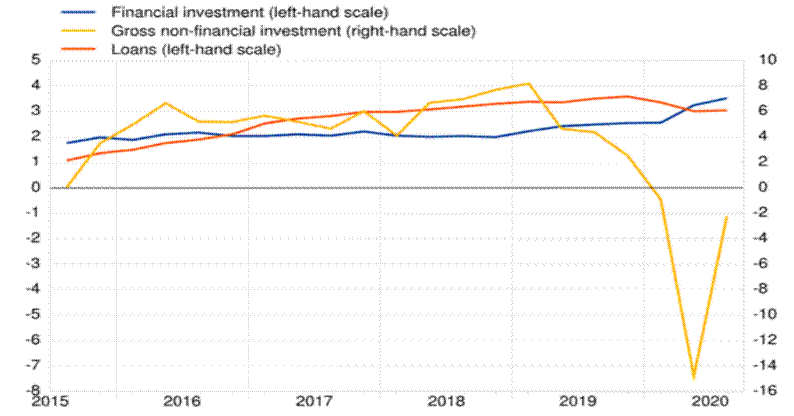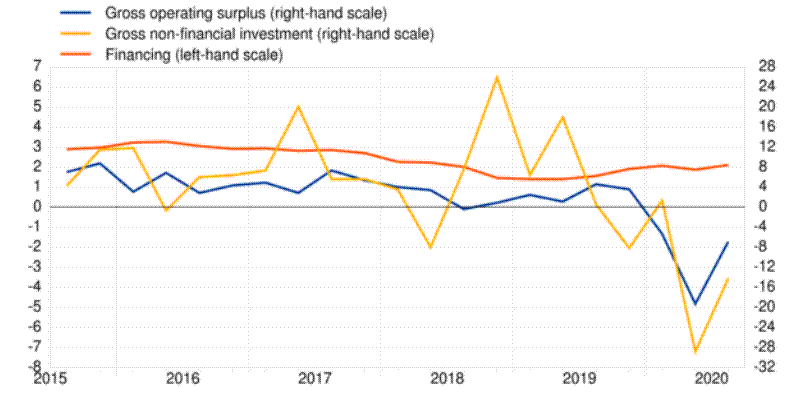- STATISTICAL RELEASE
Households and non-financial corporations in the euro area: third quarter of 2020
12 January 2021
- Households’ financial investment increased at higher annual rate of 3.5% in third quarter of 2020, compared with 3.2% one quarter earlier
- Non-financial corporations’ financing increased at higher annual rate of 2.1% in third quarter of 2020, compared with 1.9% one quarter earlier
- Non-financial corporations’ gross operating surplus decreased at lower annual rate (-6.9%) in third quarter of 2020, compared with -19.3% one quarter earlier
Chart 1. Household financing and financial and non-financial investment
(annual growth rates)

Chart 2. NFC gross-operating surplus, non-financial investment and financing
(annual growth rates)

Households
The annual growth rate of household gross disposable income increased to 1.1% in the third quarter of 2020 (after -2.9% in the previous quarter). Gross operating surplus and mixed income of the self-employed decreased at a lower rate (-1.1% after -7.3%), as well as compensation of employees (-1.6% after -7.7%). Similarly, household consumption expenditure declined at a lower annual rate (-4.1% after -15.4%).
The household gross saving rate in the third quarter of 2020 was 17.6%, compared with 16.5% in the previous quarter. The continued high savings rate in these last two quarters, calculated from four-quarter cumulated sums, is mainly explained by the strong increase of household saving in the second quarter of 2020.
Household gross non-financial investment (which refers mainly to housing) decreased at a lower rate (-2.2%) in the third quarter of 2020 (-14.8% in the previous quarter). Loans to households, the main component of household financing, increased at an unchanged rate of 3.0%.
The annual growth rate of household financial investment increased to 3.5% in the third quarter of 2020, from 3.2% in the previous quarter. Among its components, currency and deposits grew at a higher rate of 7.0% (after 6.4%), and investment in shares and other equity grew at a higher rate of 2.4% (after 1.9%). Investment in life insurance and pension schemes grew at a lower rate of 1.5% (after 1.9%). Disinvestment in debt securities continued on an annual basis, albeit at a lower rate (-4.3% after -10.2%).
The annual growth rate of household net worth was broadly unchanged at 3.9% in the third quarter of 2020. This was due to an increase in the value of housing wealth (4.8%, after 4.5% in the previous quarter) combined with net purchases of financial and non-financial assets, which together exceeded the increase in liabilities and net valuation losses on financial assets. The household debt-to-income ratio increased to 95.6% in the third quarter of 2020 from 93.5% in the third quarter of 2019, as loans to households grew faster than disposable income.
Non-financial corporations
Net value added by NFCs decreased at a lower annual rate in the third quarter of 2020 (-7.3% after -21.6% in the previous quarter). Gross operating surplus declined by -6.9% year-on-year after -19.3% in the previous quarter. Net property income (defined in this context as property income receivable minus interest and rent payable) decreased. As a result gross entrepreneurial income (broadly equivalent to cash flow) decreased at a lower rate (-7.2% after -24.2%).[1]
The annual growth rate of NFC gross non-financial investment decreased at a lower rate (-14.2% after -28.8%).[2] Financing of NFCs increased at a higher rate of 2.1% (after 1.9%), as equity financing grew at a higher rate of 1.4% (after 1.2%), and trade credit financing decreased at a lower rate (-3.1% after -4.9%). Loan financing grew at a broadly unchanged rate of 3.4%.[3] The issuance of debt securities by NFCs grew at a broadly unchanged rate of 10.3% in the third quarter of 2020.
NFCs’ debt-to-GDP ratio (consolidated measure) increased to 84.3% in the third quarter of 2020, from 79.2% in the same quarter of the previous year; the non-consolidated, wider debt measure increased to 146.7% from 139.3%. The increases in these ratios were due to an increase in the debt of NFCs and a decline in GDP over this period.
NFC financial investment grew at an annual rate of 3.2% in the third quarter of 2020, compared with 2.8% in the previous quarter. Among its components, currency and deposits increased at a higher rate of 20.3% (after 18.3%), and loans granted grew at a higher rate of 1.3% (after 0.8%), while investment in shares and other equity grew at an unchanged rate of 2.2%.
For queries, please use the Statistical information request form.
Notes
- The annual growth rate of non-financial transactions and of outstanding assets and liabilities (stocks) is calculated as the percentage change between the value for a given quarter and that value recorded four quarters earlier. The annual growth rates used for financial transactions refer to the total value of transactions during the year in relation to the outstanding stock a year before.
- Hyperlinks in the main body of the statistical release are dynamic. The data they lead to may therefore change with subsequent data releases as a result of revisions. Figures shown in annex tables are a snapshot of the data as at the time of the current release.
- The production of quarterly financial accounts (QFA) may have been affected by the COVID-19 crisis. More information on the potential impact on QFA can be found here.
- Gross entrepreneurial income is the sum of gross operating surplus and property income receivable minus interest and rent payable.
- Gross non-financial investment is the sum of gross fixed capital formation, changes of inventories, and the net acquisition of valuables and non-produced assets (e.g. licences).
- Loan financing comprises loans granted by all euro area sectors (in particular MFIs, non-MFI financial institutions and loans from other non-financial corporations) and by creditors that are not resident in the euro area.


